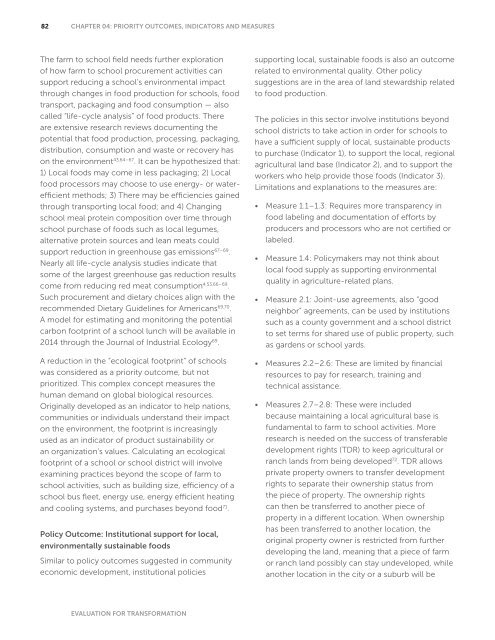Framework-08-25-14_web
Framework-08-25-14_web
Framework-08-25-14_web
You also want an ePaper? Increase the reach of your titles
YUMPU automatically turns print PDFs into web optimized ePapers that Google loves.
82 CHAPTER 04: PRIORITY OUTCOMES, INDICATORS AND MEASURESThe farm to school field needs further explorationof how farm to school procurement activities cansupport reducing a school’s environmental impactthrough changes in food production for schools, foodtransport, packaging and food consumption — alsocalled “life-cycle analysis” of food products. Thereare extensive research reviews documenting thepotential that food production, processing, packaging,distribution, consumption and waste or recovery hason the environment 43,64–67 . It can be hypothesized that:1) Local foods may come in less packaging; 2) Localfood processors may choose to use energy- or waterefficientmethods; 3) There may be efficiencies gainedthrough transporting local food; and 4) Changingschool meal protein composition over time throughschool purchase of foods such as local legumes,alternative protein sources and lean meats couldsupport reduction in greenhouse gas emissions 67–69 .Nearly all life-cycle analysis studies indicate thatsome of the largest greenhouse gas reduction resultscome from reducing red meat consumption 4,53,66–69 .Such procurement and dietary choices align with therecommended Dietary Guidelines for Americans 69,70 .A model for estimating and monitoring the potentialcarbon footprint of a school lunch will be available in20<strong>14</strong> through the Journal of Industrial Ecology 69 .A reduction in the “ecological footprint” of schoolswas considered as a priority outcome, but notprioritized. This complex concept measures thehuman demand on global biological resources.Originally developed as an indicator to help nations,communities or individuals understand their impacton the environment, the footprint is increasinglyused as an indicator of product sustainability oran organization’s values. Calculating an ecologicalfootprint of a school or school district will involveexamining practices beyond the scope of farm toschool activities, such as building size, efficiency of aschool bus fleet, energy use, energy efficient heatingand cooling systems, and purchases beyond food 71 .Policy Outcome: Institutional support for local,environmentally sustainable foodsSimilar to policy outcomes suggested in communityeconomic development, institutional policiessupporting local, sustainable foods is also an outcomerelated to environmental quality. Other policysuggestions are in the area of land stewardship relatedto food production.The policies in this sector involve institutions beyondschool districts to take action in order for schools tohave a sufficient supply of local, sustainable productsto purchase (Indicator 1), to support the local, regionalagricultural land base (Indicator 2), and to support theworkers who help provide those foods (Indicator 3).Limitations and explanations to the measures are:• Measure 1.1–1.3: Requires more transparency infood labeling and documentation of efforts byproducers and processors who are not certified orlabeled.• Measure 1.4: Policymakers may not think aboutlocal food supply as supporting environmentalquality in agriculture-related plans.• Measure 2.1: Joint-use agreements, also “goodneighbor” agreements, can be used by institutionssuch as a county government and a school districtto set terms for shared use of public property, suchas gardens or school yards.• Measures 2.2–2.6: These are limited by financialresources to pay for research, training andtechnical assistance.• Measures 2.7–2.8: These were includedbecause maintaining a local agricultural base isfundamental to farm to school activities. Moreresearch is needed on the success of transferabledevelopment rights (TDR) to keep agricultural orranch lands from being developed 72 . TDR allowsprivate property owners to transfer developmentrights to separate their ownership status fromthe piece of property. The ownership rightscan then be transferred to another piece ofproperty in a different location. When ownershiphas been transferred to another location, theoriginal property owner is restricted from furtherdeveloping the land, meaning that a piece of farmor ranch land possibly can stay undeveloped, whileanother location in the city or a suburb will beEVALUATION FOR TRANSFORMATION


